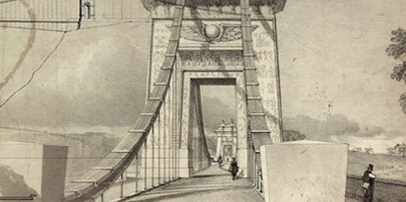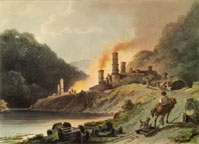


North Works, Coalbrookdale
(Elton Collection: Ironbridge Gorge
Museum Trust)

The Transept of Crystal Palace:
Dickinson Brothers lithograph
(Elton Collection: Ironbridge Gorge
Museum Trust)






Key breakthroughs in the production of iron during this period were the development of a hot-blast furnace that used coal instead of the more expensive charcoal (patented in 1828) and the design of a steam-driven hammer by James Nasmyth (1808-1890) that could shape iron with extraordinary precision (1839). With these innovations and continuing advances in mechanisation, iron could now be produced more competitively and on a much larger scale. Similarly, brick and lumber could now be produced in bulk. In 1856, Henry Bessemer (1813-1898) found a means of producing structural steel cheaply from iron using the Bessemer converter, which would become the standard method used by the steel industry for the next 120 years.
Reinforced concrete, another breakthrough in construction, was developed through a process of trial and error. Brunel’s father, Marc, had experimented with mortars in his Thames Tunnel and found that cement and iron bonded solidly. Brunel, himself, had noticed that iron shovels left coated with cement overnight were almost impossible to clean. Others had made similar discoveries over the years including the useful fact that reinforced concrete was fireproof, but no one exploited these ideas until the physician Henry Hawes Fox installed an iron and concrete floor in his private sanatorium on the outskirts of Bristol. He patented his system in 1844.
Pre-fabrication became possible with factory-made parts and easier transportation. Brunel, William Fairbairn (1789-1874), Joseph Paxton (1803-1865) and William Cubitt (1785-1861) were among those involved in the design of such structures. Paxton played a key part in the building of the Crystal Palace, which housed the Great Exhibition of the Works of Industry and Science of All Nations (1851). It had a cast and wrought iron frame, and 300,000 panes of glass.

Machinery displays, Great Exhibition: Dickinson Brothers lithograph
(Elton Collection: Ironbridge Gorge Museum Trust)
